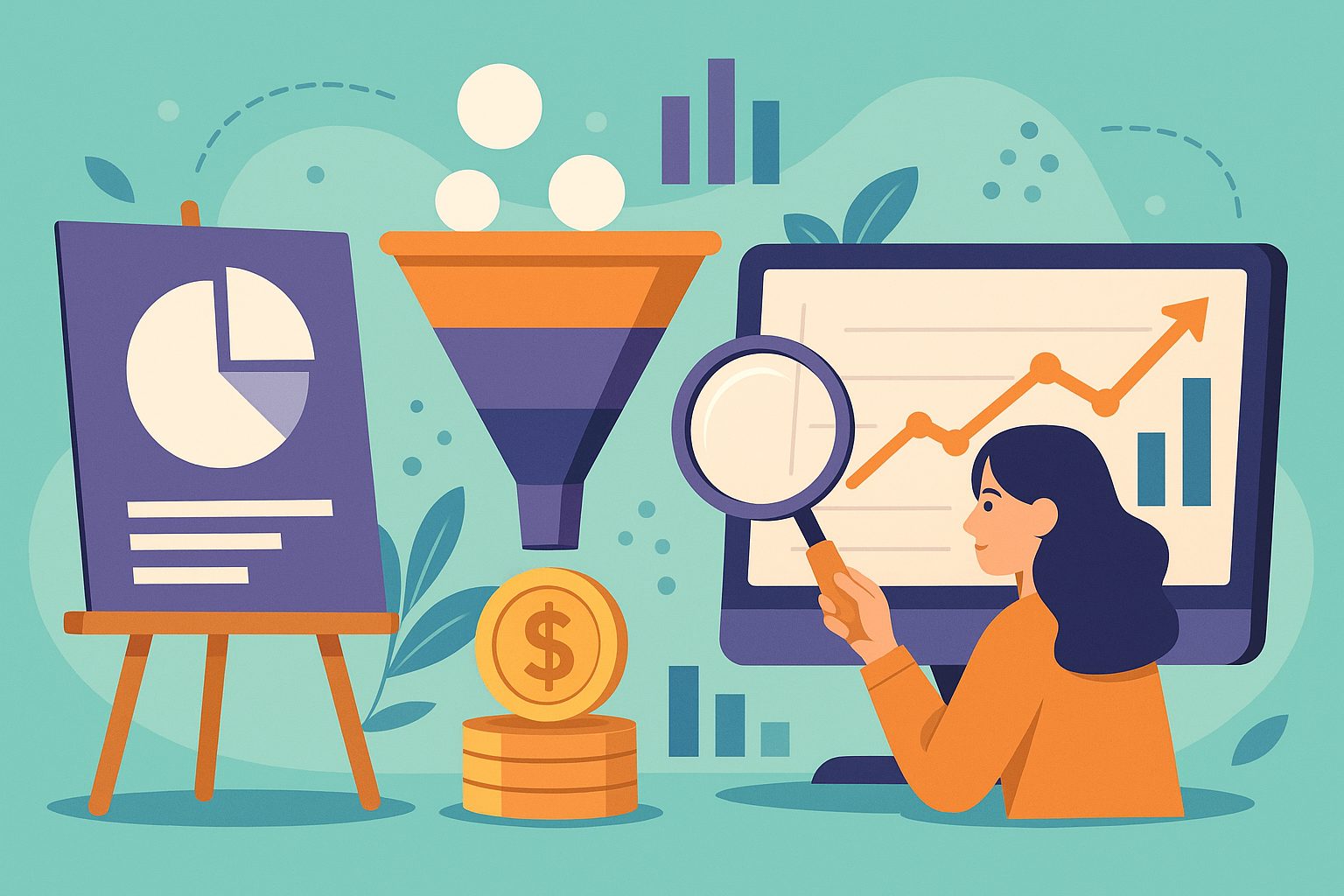Why Understanding Your Crowdfunding Funnel Is Essential
Every successful crowdfunding campaign depends on more than a compelling story and creative rewards; it hinges on a finely tuned funnel that guides curious visitors to committed backers. Without clear visibility into each stage—discovery, engagement, decision, and conversion—you’re left guessing at what’s driving traffic, where visitors drop off, and which tactics truly fuel pledges. Funnel tools transform this guesswork into clarity, revealing the precise pathways backers take and illuminating the strategies that move the needle. By deploying specialized analytics across your campaign—from pre-launch email signups to final thank-you pages—you gain the insights needed to optimize messaging, refine page design, and allocate budget where it delivers real results. In today’s competitive crowdfunding landscape, these tools aren’t optional extras; they’re the secret weapons that separate campaigns that sputter from those that soar.
Charting the Stages: From Discovery to Pledge
Before diving into specific tools, it’s vital to map out your crowdfunding funnel’s stages. First comes discovery, where visitors land on your campaign through social shares, influencer mentions, or paid ads. Next is engagement: they explore your story, watch your video, and read reward tier descriptions. Then comes decision, marked by clicks on the pledge button or form begins. Finally, conversion occurs when the backer completes their pledge and sees a confirmation. Each stage has its own dynamics and drop-off points, and understanding the flow between them is the first step to optimization. Armed with this map, you can choose tools tailored to track each segment—ensuring that no critical insight slips through the cracks.
Google Analytics 4: Your Universal Funnel Framework
Google Analytics 4 (GA4) remains the cornerstone of funnel analysis for many creators thanks to its flexible event-driven architecture. Unlike older versions, GA4 emphasizes user journeys across devices, making it perfect for multi-channel crowdfunding efforts. By defining custom events—page_view on your campaign homepage, video_start for your pitch video, form_start when the pledge flow begins, and purchase for a completed pledge—you build an end-to-end funnel in the Analysis Hub. UTM tagging on your social and email links feeds detailed attribution data into GA4, revealing which sources and mediums drive the highest conversion rates. GA4’s predictive metrics, such as purchase probability, can even forecast backer behavior before it happens—helping you target high-value prospects with precision.
Mixpanel: Deep-Dive User Event Insights
For creators craving deeper granularity, Mixpanel offers an event-centric approach that tracks individual user actions across sessions. Where GA4 shows you conversion rates at each funnel step, Mixpanel’s cohort analysis lets you understand how specific user segments—like those who watched 80% of your campaign video—behave over time. By tagging events such as tier_click, email_cta_click, and pledge_complete, you can construct multi-step funnels that reveal friction points in real time. Mixpanel’s powerful segmentation and retention reports allow you to compare different audiences, identifying which referral sources yield the most repeat backers. Its A/B testing integration means you can iterate on calls to action or reward page layouts and measure lift directly within the tool.
Hotjar: Visualizing Backer Behavior
Quantitative funnels tell you where users drop off; Hotjar shows you why. By deploying heatmaps, session recordings, and conversion funnels, Hotjar illuminates user interactions in vivid detail. Heatmaps reveal where visitors click, move their cursors, and scroll—exposing, for example, if important reward tier buttons sit below the fold. Session recordings let you watch real users navigate the campaign page, stumbling on confusing sections or skipping past key information. Hotjar’s funnel analysis tracks drop-off rates between any two pages or events, such as from the video page to the reward selection screen. These qualitative insights empower creators to tweak page elements—repositioning critical CTAs, simplifying text, or adding visual cues—dramatically improving funnel flow.
Crazy Egg: Pinpointing Funnel Friction
Crazy Egg complements broader funnel tools with its Snapshots and Confetti reports, which aggregate click data in real time. Where session recordings show individual journeys, Crazy Egg’s Confetti overlays reveal click density across all visitors, filtered by referral source or device type. This distinction can uncover, for example, that mobile users rarely tap a desktop-sized pledge button, while desktop visitors ignore secondary navigation links. Crazy Egg’s Scrollmap highlights where most users abandon the page, guiding you to place video thumbnails or testimonial snippets at high-engagement zones. The tool’s A/B testing feature lets you test alternative layouts—headline wording, reward tier graphics, or button colors—and measure conversion lift directly within Crazy Egg, closing the loop between insight and action.
Segment: Unify Your Funnel Data Sources
As your funnel spans multiple platforms—website, email, social, ads—data fragmentation becomes a challenge. Segment solves this by acting as a centralized hub, collecting event data from your website, app, email service, and ad networks, then forwarding it to downstream analytics tools. With a single JavaScript snippet, you can define events like campaign_page_view, email_link_click, and ad_conversion, and instantly stream them to GA4, Mixpanel, or any other connected service. Segment’s protocol ensures consistent naming and data hygiene, saving you from redundant tagging efforts and reducing reporting discrepancies. With unified data, you can build comprehensive dashboards that show how an email click leads to a website visit, a video play, and ultimately a pledge—crucial for attributing success across your entire marketing stack.
Kissmetrics: Revenue Funnels and Backer Lifetime Value
Kissmetrics specializes in tying funnel analytics directly to revenue outcomes, making it ideal for campaigns that evolve into e-commerce or subscription offerings post-launch. By tracking events linked to financial transactions—pledge_amount, reward_upgrade, and repeat_purchase—Kissmetrics lets you analyze backer lifetime value and cohort retention. Its funnel reports display not just conversion rates but average dollar value at each stage, revealing, for instance, that while email traffic converts at a lower rate, its average pledge size is significantly higher. Kissmetrics also supports simple A/B tests and messaging triggers based on user behavior, enabling you to send targeted promotions—like limited-edition add-ons—to high-value backers at just the right moment.
Funnel.io: Consolidated Multi-Channel Funnel Reporting
For campaigns running complex multi-channel marketing—Facebook Ads, Google Ads, email, affiliate partners—Funnel.io brings all that data into one automated dashboard. Its prebuilt connectors pull in ad spend, click metrics, email delivery stats, and web analytics, mapping them to your defined funnel steps. You can correlate budget allocation with conversion outcomes, identifying how each channel contributes to overall funding velocity. Funnel.io’s data normalization ensures consistent naming conventions, so you can compare metrics apples-to-apples—essential when optimizing cross-platform budgets mid-campaign. With custom visualizations and automated report delivery, Funnel.io keeps you and your stakeholders aligned on the channels and tactics driving the most pledges.
Heap: Capture Everything, Analyze Anything
Heap takes a “capture everything” approach, automatically recording every user interaction—page views, clicks, form submissions—without manual event tagging. For crowdfunding creators, this means you can define funnel steps retroactively: discover which element of your page triggered a pledge or identify untracked user journeys. Heap’s powerful point-and-click interface allows you to build conversion funnels on the fly, segment by user properties, and explore advanced queries—like “show me backers who watched the video and then visited the FAQ page within the same session.” Heap’s autotrack model accelerates analysis, ensuring you never miss a critical event because you forgot to configure it in advance.
FullStory: Session Replay for Funnel Diagnostics
FullStory’s session replay technology offers the most comprehensive view of user behavior, capturing every click, scroll, and input field interaction in high-fidelity replays. While conversion and drop-off metrics tell you what happened, FullStory shows you exactly how visitors moved through—or stumbled within—your funnel. You can filter replays by outcome—successful pledge or abandonment—to compare contrasting experiences and pinpoint friction points. FullStory’s frustration signals, like rage clicks or quick back-and-forth navigation, surface critical UX issues that might be invisible to heatmaps alone. By watching real visitors interact with your campaign page, you gain unmatched clarity on usability problems and can design solutions that smooth the path to pledge conversion.
Mobile Funnel Tracking with Firebase Analytics
If your campaign includes a companion mobile app—perhaps for in-app rewards or community engagement—Firebase Analytics provides seamless funnel tracking within iOS and Android environments. Custom events such as app_open, campaign_video_view, and in_app_pledge allow you to mirror your web funnel steps on mobile. Firebase’s funnel reports and cohort analysis reveal whether push notifications, deep links, or in-app messaging drive conversions more effectively than email or social. Integration with Firebase Remote Config lets you A/B test promotional banners or reward visuals in the app, measuring lift in pledge rates. With mobile funnel data in hand, you ensure your campaign optimizes across every device backers might use.
Looker and Tableau: Advanced Data Exploration for Creators
For campaigns that outgrow out-of-the-box analytics, BI platforms like Looker and Tableau offer advanced data exploration, predictive modeling, and highly customized dashboards. Looker’s LookML data modeling language lets you define your campaign metrics—pledges, video plays, form starts—as reusable constructs, then build interactive dashboards with drill-downs and embedded analytics. Tableau’s visualization engine supports complex calculations and dynamic parameters, allowing you to forecast funding trajectories based on early performance or simulate the impact of increasing ad spend. Both platforms support embedding dashboards into campaign microsites or investor portals, providing live data transparency that builds trust and encourages further investment. With these enterprise-grade tools, creators gain the flexibility to analyze every aspect of their funnel in fine detail.
Best Practices for Funnel Tool Implementation
Selecting the right tools is only half the battle; implementing them effectively is equally vital. Start by defining clear funnel stages and associated events. Use consistent naming conventions across all platforms—“pledge_start” rather than “pledge_button_clicked”—to simplify data integration. Tag every marketing link with UTM parameters and centralize tracking through a tool like Segment. Regularly audit your event schema and clean up any redundant or outdated tags to maintain data accuracy. Schedule weekly funnel reviews and automate alerts for significant drop-offs in key stages. Finally, democratize access: create simple dashboards for non-technical stakeholders, so everyone can monitor performance and contribute insights. By combining disciplined implementation with the right analytics stack, you’ll maintain a high-performing funnel that drives sustained campaign success.
Turning Data into Campaign Momentum
In the competitive world of crowdfunding, momentum is everything, and sustained momentum relies on a finely tuned funnel powered by real-time analytics. From the event-driven power of Mixpanel and Heap to the visual insights of Hotjar and FullStory, each tool brings unique strengths to illuminate how backers discover, engage with, and ultimately pledge to your campaign. BI platforms like Looker and Tableau elevate your capabilities further, offering predictive insights and advanced modeling. By implementing these funnel tools thoughtfully—defining clear stages, maintaining consistent event tracking, and creating intuitive dashboards—you transform raw data into actionable intelligence. Embrace this data-driven approach, and watch as every funnel optimization drives more conversions, faster funding, and a campaign that outperforms expectations.



